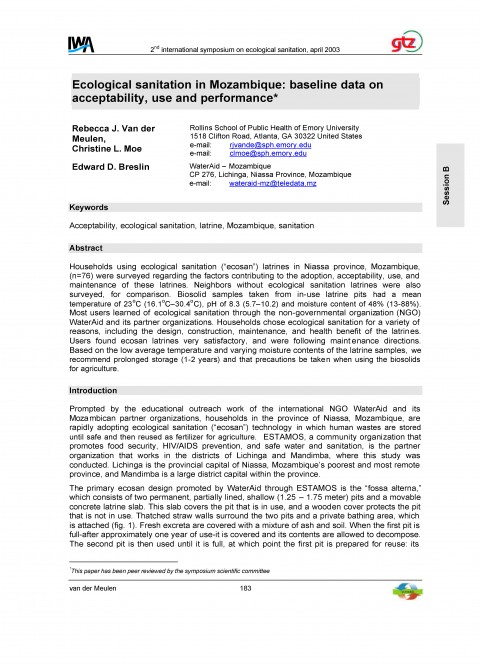Ecological sanitation in Mozambique - Baseline data on acceptability, use and performance
van der Meulen, R., Moe, C., Breslin, E. (2003)

Published in: 2003
Publisher:
2nd international symposium on ecological sanitation, April 2003
Author:
van der Meulen, R., Moe, C., Breslin, E.
Uploaded by:
SuSanA secretariat
Partner profile:
common upload
4281 Views
18 Downloads
Location of library entry
Content - Summary
Households using ecological sanitation (“ecosan”) latrines in Niassa province, Mozambique, (n=76) were surveyed regarding the factors contributing to the adoption, acceptability, use, and maintenance of these latrines. Neighbors without ecological sanitation latrines were also surveyed, for comparison. Biosolid samples taken from in-use latrine pits had a mean temperature of 23oC (16.1oC–30.4oC), pH of 8.3 (5.7–10.2) and moisture content of 48% (13-88%). Most users learned of ecological sanitation through the non-governmental organization (NGO) WaterAid and its partner organizations. Households chose ecological sanitation for a variety of reasons, including the design, construction, maintenance, and health benefit of the latrines. Users found ecosan latrines very satisfactory, and were following maint enance directions. Based on the low average temperature and varying moisture contents of the latrine samples, we recommend prolonged storage (1-2 years) and that precautions be taken when using the biosolids for agriculture.
Bibliographic information
van der Meulen, R., Moe, C., Breslin, E. (2003). Ecological sanitation in Mozambique - Baseline data on acceptability, use and performance. 2nd international symposium on ecological sanitation, April 2003
Filter tags
English Sub-Saharan Africa















